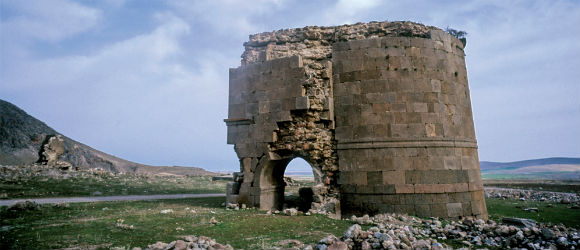Paul and Barnabas went from Lystra to Derbe after Paul the Apostle had recovered from being stoned.
An altar stoııe has been found in Kerti Höyük with an inscription that has the names of Derbe and Bishop Michael carved on it. Without other evidence of the city it is unfair to say it establishes the original site of Derbe because such stones are often moved. However it is probable that one of three tumuli near Kara-man is the actual site. Degle (near Bin Bir Kilesi and Madensehir) is a fourth possibility. The stone in question and another from Lystra are in the courtyard of the Konya Arkeoloji Müzesi. The present-day traveller who wishes to try to find Derbe would be well advised to engage a local guide in Karaman.
Derbe was the royal seat of the tyrant (absolute ruler) Antipater Derbetes who was also known as Anti-pater the Pirate. A hundred years before Paul and Barnabas were there Antipater had entertained Cicero while he was governor of the neighboring province of Cilicio. Derbe was the last Roman city on the road to the east, so it was the point at which customs were collected.
No details of Paul’s first stay in Derbe are reported, and the only other possible reference to it outside of its being mentioned in the second journey is the identification of one of Paul’s companions between Greece and Troas as “Gaius the Doberian” or “Gaius the Der-baean”. Paul and Barnabas both spoke to people in Derbe and won many converts (Acts 14:21); their ties with the people there continued strong enough that Paul returned a year or so later.
Derbe,


Excavations near Karaman in southern Turkey have begun to uncover remains from ancient Derbe, a site of Paul’s evangelizing in Acts 14-16. According to Dr. Mark Wilson,* director of the Asia Minor Research Center in Antalya, Turkey, Derbe was one of the only known New Testament sites left unexcavated in Turkey, along with Colossae and Lystra. Karaman governor Murat Koca told Hurriyet Daily News that “We think the place where he [Paul] lived is this tumulus. Works are continuing to prove this fact. This excavation has much importance to Karaman, because if we can find a work from the early period of Christianity, this place will be an important center for faith tourism.”
On their first missionary journey, after traveling through Cyprus, Perga and Pisidian Antioch (Acts 13), Paul and Barnabas preach in Iconium, from where they were forced to flee “to Lystra and Derbe, cities of Lycaonia, and to the surrounding country; and there they continued proclaiming the good news” (Acts 14:6-7). After facing difficulties in Lystra, Paul “Went on with Barnabas to Derbe. After they had proclaimed the good news to that city and had made many disciples, they returned to Lystra, then on to Iconium and Antioch” (Acts 14:20-21). Using the Barrington Atlas of the Greek and Roman World, Wilson notes the great distances covered in this brief statement: Travel from Derbe to Lystra (via Laranda) covered 81 miles, from Lystra to Iconium was another 21 and travel from Iconium to Pisidian Antioch would have taken the travelers across an additional 92 miles.
Paul and Barnabas covered 192 miles to return to Pisidian Antioch before turning south back toward Perga on the Anatolian coast. In Acts 16, Paul returns to the area with Silas, where they meet the disciple Timothy.